
I remember hearing the place names when I was a kid. Strange sounding, exotic names: The Dardanelles, Gallipoli, ANZAC Cove, The Nek and Lone Pine. I remember seeing the scratchy black and white footage of troops on the beach, and of trenches and camps dug into the steep cliffs. I later discovered that a relative on my father’s side, Jack Gibbs, had been at Gallipoli in 1915. Visiting Gallipoli was the reason I had returned to Turkey.
My relative Jack left Melbourne with the 5th Battalion, 8th Reinforcements on 17th April, 1915, eight days before the first ANZAC landing at Gallipoli. At present I don’t know much about Jack’s time on the Peninsula, but what I do know for sure is that my leisurely arrival on the ferry from Canakkale was nothing like what Jack experienced.
My ferry arrived at the terminal in Eceabat, a small seaside village on the west coast of Gallipoli Peninsula. Walking along the waterfront towards my hotel, I passed the ‘Respect for History’ park, which featured a scale model of the Peninsula marked with the location of military operations during World War I. Also on display was a confronting diorama showing the Turks and ANZACS facing off across no-man’s land.
‘Distance between the mutual trenches is eight metres…’ Colonel Mustafa Kemal regarding the Battle of Quinn’s Post

After checking into the small family hotel, I hired a car and began exploring. As I started to look around, two things were immediately striking. Firstly, the Gallipoli Peninsula is beautiful, with deep green pine forest covering the steep country, and the flats a patchwork of blazing sunflowers, orchards and golden wheat fields.

The views offered from the hills are exquisite, with the rolling country giving way to expansive vistas across the Dardanelles and the Aegean. Secondly, the Turkish people are very passionate about the history of the Peninsula, and the area is dotted with memorials, cemeteries, and signs providing detailed information on the Dardenelles campaign.
Early in my stay I visited the Kabatepe Promotion Centre and Museum. Though not suggested by the name, this facility is the premier museum dedicated to the battles fought on the Peninsula during WW1.
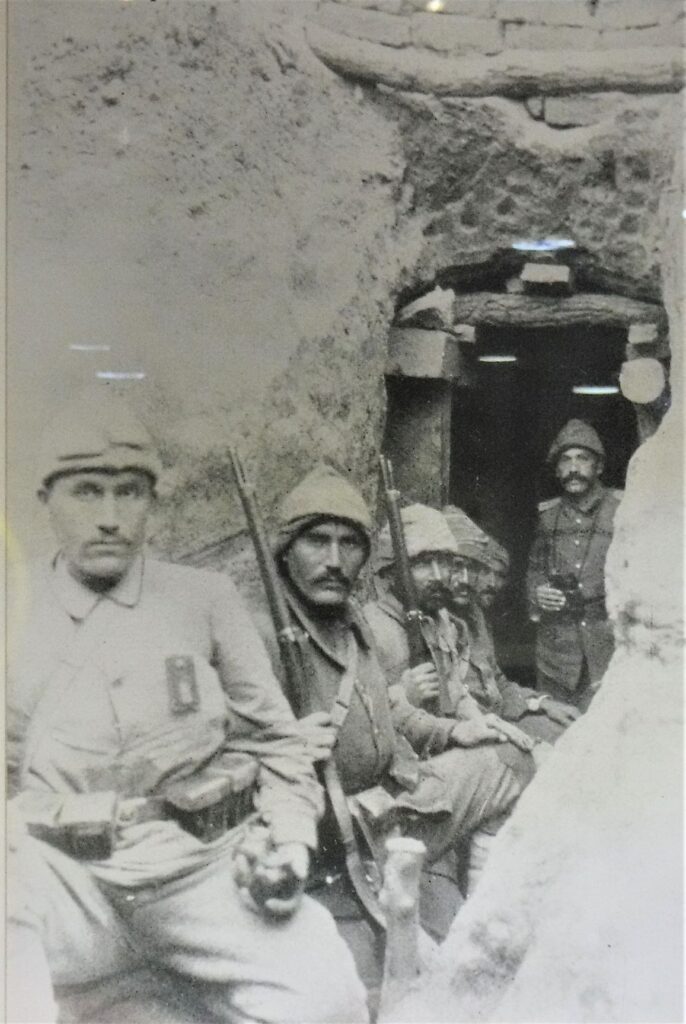
Although some of the exhibits were closed, presumably because of Corona, the museum was impressive and provided a detailed background of the geopolitics that lead to the outbreak of WW1, and ultimately the battle for Gallipoli.
Grim determination: shared humanity dictated that both Turkish troops and the Allies suffered similar horrors, deprivations and hardships during the war on the Dardenelles. Photograph from the Kabatepe Promotion Centre and Museum
I couldn’t find a decent map of the historic sites around the Peninsula, so figured I would just work my way from the southern tip up to the Anzac Cove area. That’s one thing about exploring a peninsula: with water on three sides it’s pretty hard to get lost.
I began by following the signs to Canakkale Martyrs’ Memorial, which is the primary monument to the Turkish soldiers lost during the war. When I arrived it was a warm summer’s afternoon, and with school out for holidays there was a steady stream of families visiting the cemetery and the many statues and sites that make up the Memorial.



The Commonwealth War Graves Commission looks after the 31 cemeteries holding the allied servicemen who died during the Gallipoli campaign. The cemeteries are uniform in design, and Turkish employees of the CWGC maintain the sites immaculately. A similar number of Turkish cemeteries are located on the Peninsula. Driving from Cape Helles in the south to Suvla Bay in the north, the cemeteries are found overlooking the sea, amongst the neat paddocks, and within quiet copses of pines.

‘The fire changed the colour of the sea with the blood from the bodies of the enemy – a sea whose colour had remained the same for years…The shore became full of enemy corpses, like a shoal of fish.‘
Major Mahmut, 3rd Battalion, 26th Regiment, describing the British landing at V Beach1
I am the only visitor when I arrive at the Hellas Memorial, which stands near the beaches where the British forces landed on April 25th 1915. A cool sea breeze is blowing, and the sun reflects fiercely from the pale sandstone courtyard. Upon the monument are the names of over 20,000 men who died on the Peninsula but have no know grave.
‘Cape Helles, where we had landed, was the general stepping-off place, and a mile of land had been taken. The loss of life had been out of all proportion to this gain, due to the prepared positions of the Turks right down to the water’s edge, which enabled them to mow down our men with ridiculous ease.‘ Private F. T. Wilson, 16th Battalion, Manchester Regiment2
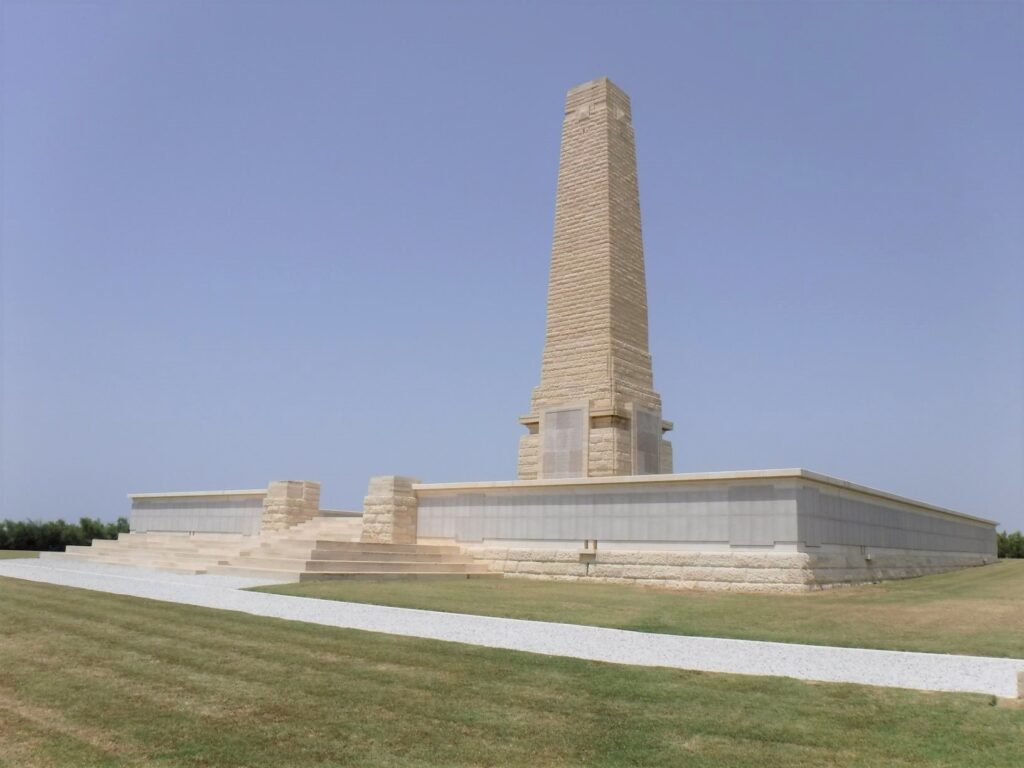
Turning off the tar and navigating a dirt track in the hire car, I arrived at W Beach, where several families were enjoying a dip in the cool waters of the bay. The remains of a lighter, or barge, lie on the high tide mark, a reminder of the British landing at the site in 1915. It is not for the first time, or the last, that I struggle to reconcile the scene of peace and natural beauty before me with the horrific events that occurred here 106 years ago.

‘Later in the evening we got back to our bivouacs near W Beach….Men of all nationalities had to be buried where they fell, or in a communal grave, to be trodden on by the living, who came forward unaware of what the soil under their feet were hiding.’ NCO J. Murray, Hood Battalion Royal Naval Division3
Heading north up the west coast of the peninsula is a beautiful drive. After passing the small port village of Kabatepe, the road forks, with one route following the coast and leading to ANZAC Cove and beyond, and the other climbing the range to the top of the higher country overlooking the sea. I decided to explore the coastal road first.
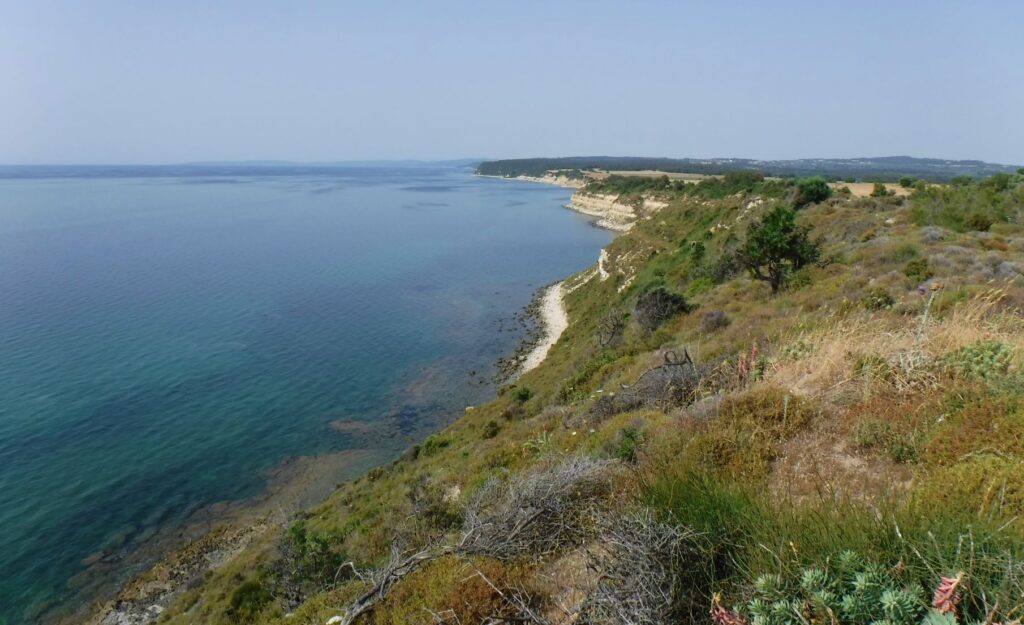
Approaching ANZAC Cove, the thick scrub rose to steep bare cliffs on my right, and on my left the Aegean sparkled in the afternoon sun. The road was empty, and I slowed right down, staring up at the crumbling cliffs that would have faced the landing forces so long ago. I parked the car and walked to the verge overlooking ANZAK Koyu, a tiny stretch of pebbly shore, where men – and mere boys – arrived in their thousands in 1915. Would anyone, naive to the catastrophe that began in the early morning of April 25, sense that something monumental had happened here? I suppose not. Standing above this this serene, pretty cove, it was hard to imagine the slaughterhouse it had been in 1915.
‘As soon as our cutter struck the shore everyone jumped into the water…we scrambled out and doubled across the beach to a low bank to form up. One of our boys fell badly wounded on the edge of the water, there were several of our boys’ bodies in the water and lying on the beach, also several badly wounded and dying on the beach.’ Lieutenant J. Adams, 54th Battalion AIF4
The day I drove the steep road to the plateau that overlooks the ANZAC landing site was fine and sunny, just like every day I had spent on the Peninsula. It is summer, the daily temperatures are in the low 30s, and the dry grass crackles underfoot.
Lone Pine Cemetery is built upon old Turkish trenchlines, and includes an impressive monument to the nearly 5000 ANZAC troops killed in the area who have no known graves. On the slope beneath the cemetery, some of the scrub has been cleared to show the maze of trenches, still visible 116 years on.

‘In one charge it was so hot that we had no time to remove the wounded…we had to tread on these poor dead and dying men lying in the trench to keep the gaps in the line filled…the trenches were indescribable…Turks and Australians often locked in a last death struggle, still lay there in large numbers in spite of all efforts. Many had in fact been removed but they were so many in all that no real impression had been made…The Brigadier came down and congratulated us and said we have added to the reputation and our glory which will last for ever etc etc. but you could have my share of all the glory of the Battle of “Lonesome Pine” for one of the poor boys who died or was mangled to death there.’ P. Elliot, Commander 7th Battalion AIF5

The road traces the old front line as it winds on towards the heights of Chunuk Bair. In some places, such as Quinn’s Post, the opposing trench lines were located where the road verges now sit. Some of the area has been cleared and is maintained to prevent the scrub regrowing, permitting visitors to walk both the ANZAC and Turkish trenchlines. Standing in the trench, looking across at road at the opposing fireline, I found myself shaking my head in dismay. It was just so close.
Trenches below Lone Pine
The Turkish trenches were only seven yards away, and at one point we had a listening post just six feet from their line. One could step out through a gap in the sandbags and touch the Turkish parapet – but one was much better advised not to…The Turkish bombing was incessant and terribly effective, and their rifle fire was deadly. To look over the parapet was suicide, and even a periscope would be shattered if held a moment too long.’ Private C. Malthus, Canterbury Infantry Battalion6
Excellent interpretive signage placed along the road allows you to picture the locations as they looked during the Gallipoli Campaign. This is Steele’s Post in 1915, and 2021.
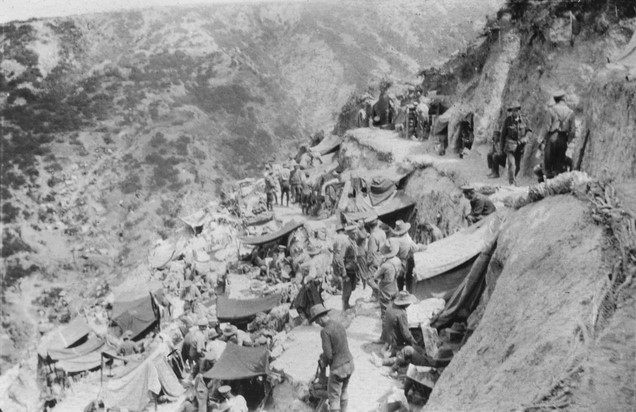

I walked out of the pine forest and onto the slippery dirt track along Walker’s Ridge. The view from near the top of the ridge gives an indication of the steep country in which the ANZACs and Turkish forces met. ANZAC Cove is to the south (left) of the first small headland, then North Beach which became the main location for supplying the landed forces.
‘From the trench down to the beach (along Walker’s Ridge), about 4 miles…is one long line of grey stiff bodies of men who have died trying to get down to the beach unassisted.’ Sergeant H. Jackson, 13th Battalion AIF7
A little farther on, I turned the car off the main road and drove the shaded track to The Nek Cemetery. Considering the enormous loss of life that resulted from the 3rd Light Horse Brigade’s suicidal charge at the Turkish lines, I was surprised at how empty the cemetery appeared. Shortly after I found out from the information provided that there were in fact 326 men buried at The Nek, but the horrific nature of the conflict meant that only ten could be identified. Just ten.
‘The whole thing was nothing but bloody murder.’ Colonel N. Brazier, Commander, 10th Light Horse8
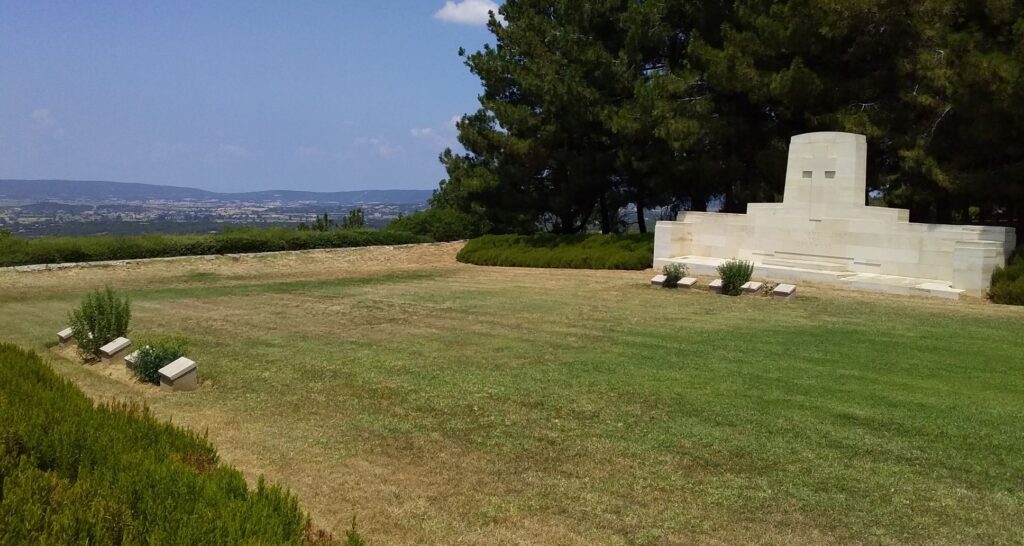
A short distance from the cemetery across the crunchy fallen pine needles was a series of water tanks, brought up from the beach by the Australians in an effort to manage the chronic water shortage at the front.

“Hell on earth. My nerves are shattered. Just about dead with thirst and hunger, my God I will never forget the flies and the sand.’ Private C. Hardy9
The road climbs steadily to towards the peak of Chunuk Bair. Parking up, I walked the old trench lines to the top of the hill, now marked by the main New Zealand memorial on the Peninsula. From there I could see the blue of the Dardenelles Straits shimmering in the sun to the south-east. Kiwi and British soldiers had seen the same waterway, the control of which was the ultimate goal of the Gallipoli Campaign, after taking the position on August 8th 1915. After holding Chunuk Bair for two nights, the Turks re-took the hill and held it until the allied withdrawal.
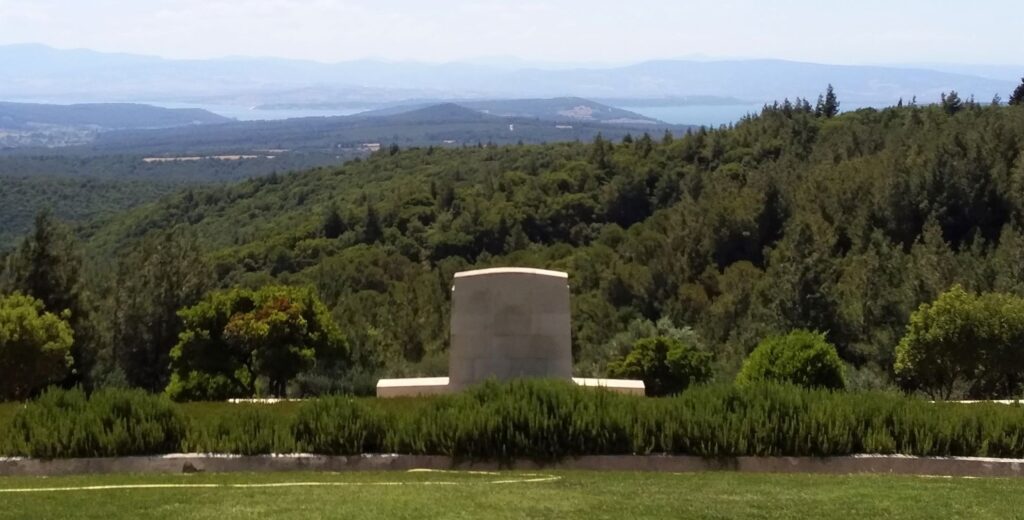
‘All my mates got were wooden crosses.’ Corporal C. Basset, New Zealand Divisional signal Company, recipient of the Victoria Cross at Chunuk Bair10
To the north of ANZAC Cove and North Beach, the coast curves north-west in a sandy arc to small point, beyond which lies Suvla Bay. I drove past the paddocks of sunflowers towards the Bay, stopping at the Hill 10 Cemetery. As Australians, we naturally think of the involvement of the ANZAC and British forces in the Dardanelles Campaign. However there were many more nations involved in the offensive, including France, Senegal, India, Nepal, and labourers from Greece and Syria.
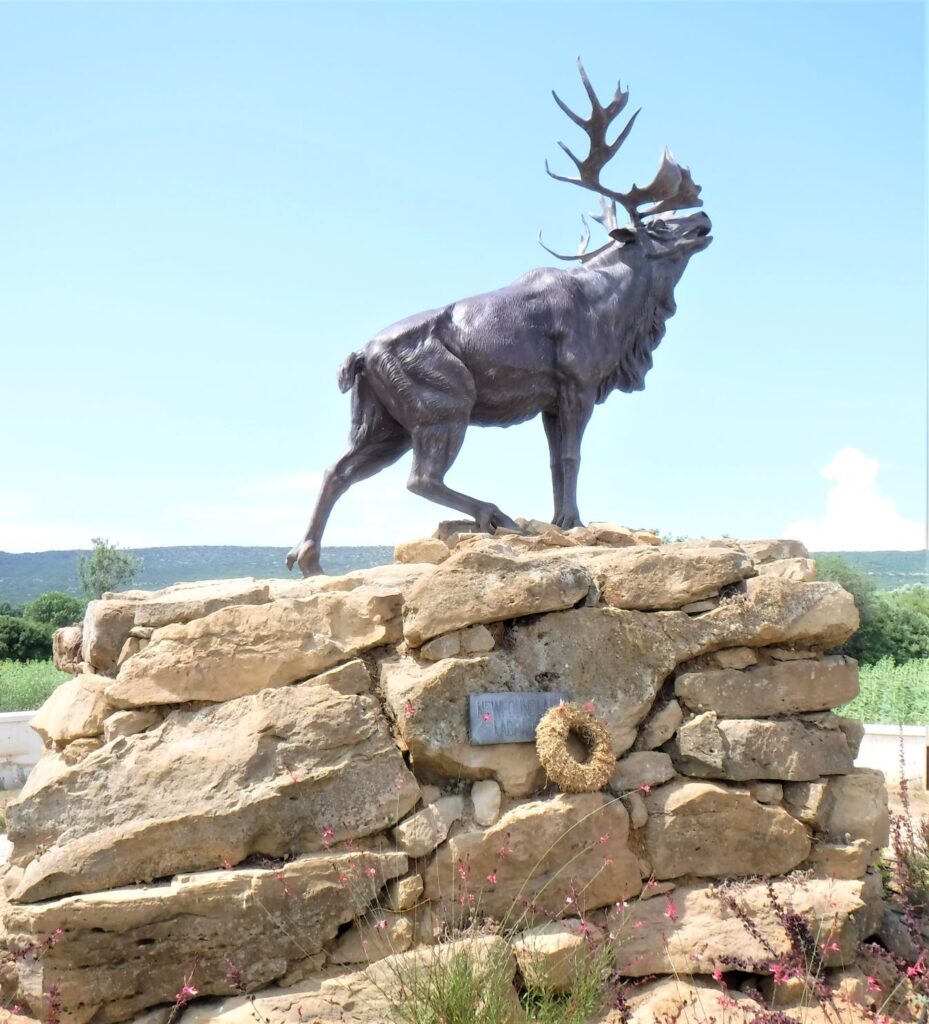
The caribou statue at Hill 10 Cemetery commemorates the participation of the Newfoundland Regiment in the Gallipoli conflict (the British Dominion of Newfoundland became a province of Canada in 1949).
‘It was the first shell I had ever heard. It came over the hill close to me, screeching through the air like an express train going over a bridge at night. Just over the boat I was watching, it exploded. A few of the soldiers slipped quietly from their seats to the bottom of the boat.’ Lance-Corporal J. Gallishaw, Newfoundland Regiment11
The small carpark at Suvla Bay was busy, with weekend beach goers struggling down to the sand with their chairs, picnic goods and umbrellas. The northern end of the beach is idyllic, with a broad golden beach, turquoise water, and a picturesque rocky headland. I headed off south along the water’s edge, passing kids splashing and laughing and their parents relaxing on the sand. Soon I had the Bay to myself, and came across a reminder of less peaceful times; a lighter from the British landings in August 1915 lying in the shallows.

‘And then of course we all got into lighters, smaller boats, and got ashore as quiet as we could….the Turks were waiting for us. But us that eventually got ashore, we dug in and then we advanced when we could during that night. I think we advanced about three miles during that night, and that was furthest that they got all the time they were there. They never went any further than three miles.’ F. Caokes12
After my walk I drove to the end of the dusty dirt track which terminates at the northern end of the bay. A large concave memorial, common across the Peninsula, sat on the clifftop.

After 10 months on the peninsula, the Allies had made little progress beyond their initial gains achieved after landing on April 25th 1915. After suffering 46,000 killed, all forces were evacuated by early January 1916. The Turkish people had lost 85,000 defending Gallipoli.
I am ashamed at leaving so many of my pals behind. We all came here together, full of hope, and in the furtherence of that hope many have died. Their hopes and their bones are scattered in this desolate waste we are about to desert…Those of us who survive will be tormented by this fiasco, even though it was no fault of ours. We fought well and suffered dreadfully, we could not do more, but in the end, we deserted them.’ NCO J. Murray, Hood Battalion Royal Naval Division13
I had originally planned to spend a week visiting Gallipoli, but ended up staying nearly a month. I am yet to find out how long my relative Jack Gibbs spent here. I do know that he fell seriously ill at Gallipoli, like thousands of others, and was evacuated due to his condition. I also know that he never recovered, and died in his home in Colac, Victoria, being tended to by his father, aged only 20 years.
Gallipoli is a beautiful place with a fascinating, tragic history. The Turkish people are committed to keeping this history alive, and ensuring that visitors have the opportunity to discover and learn. As possibly the only international tourist on the Peninsula, I was often asked where I was from, and always received the same response: ‘Ah….Australia. Welcome’.
Lest we forget.
1P. Hart (2015) Gallipoli: V Beach Madness, GALLIPOLI: V Beach Madness | Military History Matters (military-history.org)
2(2000-2009) Memoirs and Histories: A Boy at Gallipoli, First World War.com – Memoirs & Diaries – A Boy at Gallipoli
3,13J. Murray, Gallipoli 1915
4J. Adams (1915) Personal Diary, Diary and photograph of John Adams, 1914-1916 | Australian War Memorial (awm.gov.au)
5P. Elliot (1915), quoted in Letter Home, 2015, Roads to the Great War (roadstothegreatwar-ww1.blogspot.com)
6Malthus, C. (1915), quoted in Private Cecil Malthus, Canterbury Infantry Battalion, Private Cecil Malthus | Ngā Tapuwae Trails (ngatapuwae.govt.nz)
7Jackson, H. (1915), quoted in Walker’s Ridge Cemetery, Walker’s Ridge Cemetery – Anzac Portal (dva.gov.au)
8Brazier, C.N. (1915), quoted in How Anzacs’ Battle at Nek Went Wrong, 2015, How Anzacs’ battle at Nek went wrong (sbs.com.au)
9Hardy, C. (1915), quoted in Digger’s Diary Recounts ‘Hell on Earth’, Digger’s diary recounts ‘hell on earth’ – ABC News
10Bassett, C. (1915), quoted in 1915 Battle of Chunuk Bair, 1915 Battle of Chunuk Bair | Fields of Remembrance
11Gallishaw, J. (1915), quoted in Newfoundland and Labrador in the First World War, 2015, The Newfoundland Regiment at Gallipoli (heritage.nf.ca)
12Caokes, F. (1915) quoted in Voices of the First World War: Gallipoli, 2021, Voices of the First World War: Gallipoli | Imperial War Museums (iwm.org.uk)
If you enjoyed this post, you may also like The Cemeteries of Gallipoli, HMS Lundy and HMS Louis
Do you have a particular interest in World War I, II and the Cold War? Check out my other blog Ghosts of War. If you enjoy military history, and want to know what it’s like to visit both significant and lesser-known wartime locations today, there’s something there for you.
Leave a Reply